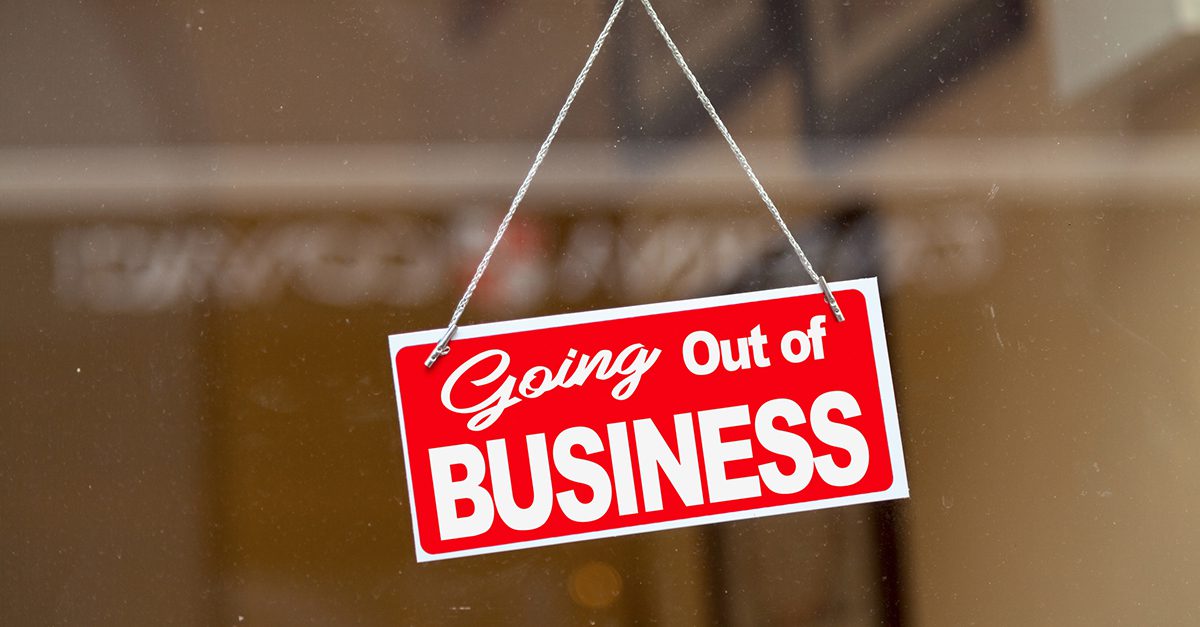
Closing a small business is never an easy decision, especially when it is burdened by debt. For unincorporated business owners in Canada, the process can be even more daunting due to the personal liability associated with business debts. The more you know about the bankruptcy process, and the earlier you reach out to a debt professional for advice, the more flexible your options will be.
Table of Contents
What Happens to Debt When a Business Closes?
Small business bankruptcies are up in Canada, with the Office of the Superintendent reporting roughly 2,000 business bankruptcies in 2024, up more than 50%. Not all small businesses will even file bankruptcy, some will simply close.
If your business closes and it owes money, does this mean you need to file personal bankruptcy? The answer depends on whether you are personally liable for business debts.
Proprietorship and Unlimited Partnerships
As an unincorporated business owner, you are personally responsible for the outstanding debts and obligations of your business. There is no legal separation between you and your business, meaning creditors can pursue your personal assets—such as your home, car, or savings—to recover unpaid debts.
Examples of unincorporated business owners include:
- Freelancers and independent contractors
- Sole proprietors
- Unlimited partnerships
- Consultants operating without incorporation
It’s not uncommon for a sole proprietor to mix personal and business debt. For example, they often use personal credit cards to fund their business. This is another reason why personal bankruptcy becomes necessary to gain a fresh start. Both personal and business debts can be taken care of through the same filing.
Corporations
A business that is incorporated is a separate legal entity on its own. If a corporation files bankruptcy, its assets are sold, subject to any rights of secured creditors, and the money is distributed in satisfaction of any business debts. A corporate bankruptcy is costly (professional fees can be $20,000 or more) and usually involves both a Licensed Insolvency Trustee and a bankruptcy lawyer. An incorporated business can be closed without filing bankruptcy if there are no assets involved. The business can simply close and walk away from any company debt.
Personal Guarantees
Whether your business was incorporated or not, you are also personally liable for any business debt you have personally guaranteed.
Directors can also be held personally liable for specific statutory obligations, including unremitted HST or GST under the federal Excise Tax Act, unpaid payroll source deductions under the federal Income Tax Act and certain wages under provincial Employment Standards Acts. These types of debts are typically called Director’s liabilities. Businesses that have been using tax remittances as operating cash often cannot catch up on these obligations before the business ends up failing.
Considering Bankruptcy or Consumer Proposals
If you are personally liable for business debts and creditors are unwilling to negotiate, personal bankruptcy or a consumer proposal might be viable options. Here’s how each works:
-
Bankruptcy: This legal process eliminates most unsecured debts but involves surrendering certain assets and significantly impacts your credit rating.
-
Consumer Proposal: If your total debts (both personal and business), not including your home mortgage, fall below the $250,000 debt limit, you may be able to file a consumer proposal. This is a formal agreement to repay a portion of your debts over time. It is less severe than bankruptcy and allows you to retain more assets.
-
Division I Proposal: If your debts are larger, it is still possible for an individual business owner to file a Division I Proposal to creditors. A Division I proposal has the same result on your debts but has a slightly different administration structure and, if not accepted by your creditors, it has the added risk that you will automatically be declared bankrupt.
All these options require the assistance of a Licensed Insolvency Trustee, who will guide you through the process and ensure your rights are protected.
What Are The Implications of Filing Personal Bankruptcy?
Province-to-province, the rules differ. But regardless of where you live, there are consequences to filing insolvency.
Asset Retention
First, you may lose some personal assets. There are provincial and federal bankruptcy exemptions, including essential personal and household assets (e.g., clothes, furniture, other personal items), a small car and most RRSP and pension savings. However, if you have equity in your home or non-registered investments, these will need to be liquidated to satisfy your creditors. In these situations, most people choose to file a consumer proposal as an alternative to bankruptcy as a consumer proposal allows you to keep possession of all your assets.
One area of concern for tradesperson is tools of the trade. Most provinces have exemptions that allow you to keep a certain dollar value of tools and equipment or business assets necessary to operate your business and earn a living. In Ontario, you can keep up to $14,405 in tools and equipment (at resale value, not new cost).
If you are a shareholder in a company and file personal bankruptcy, your shares become property in your bankruptcy estate to be sold for the benefit of your creditors. This may be a consideration if you own other companies.
Duties
Pragmatically, you’ll face fulfilling specific duties during the bankruptcy process. For instance, you must report your income each month. The government sets a level of what you’re allowed to earn – and if you go above this amount, you must pay more. These extra earnings are called surplus income. If your future income is uncertain, discuss this with your Licensed Insolvency Trustee. They will help you with the decision of whether it makes more sense to file bankruptcy or a consumer proposal to better structure these surplus income payments over a longer period, reducing your monthly payments.
Most provinces, including Ontario, have legislation prohibiting someone who is bankrupt from being a director of a company until they are discharged. Upon filing bankruptcy, you must resign. Once you are discharged, you may be appointed as director again. You can file a consumer proposal and remain a director since you are not bankrupt.
Secured Debts
Since a bankruptcy or consumer proposal does not deal with secured debt, you will want to ensure you can keep up with secured payments if you file insolvency to deal with unsecured creditors. While your car loan lender and mortgage lender cannot demand payment of your loan just because you filed bankruptcy, this is not always the case with a secured business loan. Read your loan agreement carefully for any default clauses that might need to be addressed.
Tax obligations
Almost all small business bankruptcies involve tax debts. Often the first payments to be deferred for cash flow purposes are GST or HST remittances and payroll deductions.
Government debts are considered unsecured debt in a bankruptcy or consumer proposal and are dischargeable business debts. The key is to act before Revenue Canada places a lien on any assets converting an unsecured debt into a secured debt.
CEBA loans and CERB
What about debts related to COVID-19 support programs? The federal government provided several programs to help businesses through the pandemic, notably the Canada Emergency Business Account or CEBA loan and Canada Emergency Wage Subsidy. Some small business owners (or self-employed workers) may also have collected CERB while their business was subject to shutdown restrictions.
It is possible to include CEBA loans and other government pandemic debts in your bankruptcy as long as those payments were not received through fraud. We filed several small business insolvencies with a CEBA loan and also help self-employed workers file insolvency for CERB repayment and taxes owing on CERB income.
Can You Restructure The Business?
Filing a bankruptcy or consumer proposal does not mean you have to close your business. People who file for personal bankruptcy can still run their own business.
If your business is viable, it is possible to restructure your debts through an insolvency proceeding and carry on operating your business. Declaring bankruptcy or making a proposal to creditors can provide you with creditor protection while restructuring and reorganizing.
One problem that stems from filing for personal bankruptcy and running your business is you may struggle with access to new credit. Both a bankruptcy and proposal will appear on your credit report. Suppliers may or may not be willing to offer financing options since you’re no longer classified as a trustworthy borrower. It’s something to consider before filing. You may be able to change vendors, and you will be able to take steps to restore your credit once your debts are eliminated.
Avoid Creating Preference Payments
If you are facing financial difficulty and your business is at risk, it’s important not to pick and choose your favourite creditors to repay.
Under bankruptcy law, a Licensed Insolvency Trustee is required to inquire into payments, or transfers of property, made in the three months prior to the date of insolvency (12 months in the case of non-arm’s length transactions). Make a payment to one creditor in preference to another, and your trustee may ask to have this transaction set aside. Such an act is called as a preference under the Bankruptcy & Insolvency Act, and can jeopardize your discharge.
If you have some business assets and are thinking of filing personal bankruptcy, discuss the right course of action with your Licensed Insolvency Trustee. They will help you decide if you should liquidate these assets at fair market value before filing with the funds distributed in proportion to your creditors to maximize returns or whether it is best to surrender these assets into your bankruptcy. In either case, be aware that all transactions immediately prior to your filing will be under review, so talk to your trustee before making any decisions.
This is also why it is key to seek advice from a debt professional as early as possible if you are struggling. It is usually much easier to prevent a bad move than it is to try to undo one.
How Do I File Personal Bankruptcy for Business Debts?
Closing a business in debt is a challenging and emotional process, but it also provides an opportunity to reset and rebuild. If your business is struggling financially due to excessive debts, talk with a Licensed Insolvency Trustee about your options. Your accountant can give you a picture of what your balance sheet and cash flow will look like, but a LIT can advise if eliminating old debt through a bankruptcy or consumer proposal is a good option for you.
Sole proprietors and partnerships with nowhere to turn, mounting debts, and non-existent revenue for the next while might have no choice but to file for personal bankruptcy or make a proposal to their creditors.
The key here is that every situation is unique and often complicated. A Licensed Insolvency Trustee will ask questions to help you narrow down the options and possibilities. They will explain the implications of filing insolvency and help you determine the most appropriate way to move forward. They will help you achieve your goal to either close the business and walk away with a fresh start or start over with a restructured balance sheet that will ensure your business returns to profitability down the road.
Similar Posts:
- Debts You Can and Cannot Include in a Consumer Proposal
- Can I Be A Director, Executor or Be Bonded If I File A Consumer Proposal?
- How Much Debt Does it Take to File Bankruptcy in Canada?
- Can You Switch Between Bankruptcy and Consumer Proposal?
- Personal vs Business Bankruptcy? Understanding Small Business Bankruptcy





